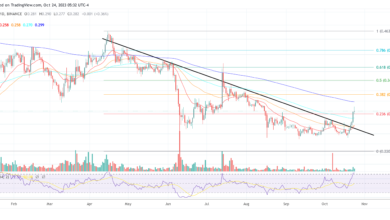As the NFT market continues to bleed, is there a recovery in sight

- The NFT market underwent a sharp decline, with Bored Ape Yacht Club (BAYC) NFTs facing a historic price drop.
- ApeCoin gets affected as price and interest from whales begins to wane.
In recent months, the NFT market witnessed a gradual decline in interest and engagement. This downturn has been particularly noticeable over the past few weeks, as the decline in interest within the NFT sector has intensified, impacting various facets of the NFT space.
Realistic or not, here’s APE’s market cap in BTC’s terms
Declining health
According to ASXN’s data, one stark example of this market shift is the floor price of Bored Ape Yacht Club (BAYC) NFTs. This floor price has experienced a sharp decline, hitting a historically low value of 23 ETH. Consequently, a substantial number—more than 108 of BAYC NFTs faced the risk of liquidation.
Delving deeper, it’s noteworthy that BendDAO, which actively contributes to the BAYC ecosystem, had 32 BAYCs with a health factor equal to or below 1.1. This figure includes 8 NFTs that have an even lower health factor, at 1.05 or less.
BendDAO adopts a method that calculates floor prices based on a time-weighted average, which positions the BAYC floor price at 25.02 ETH.

Source:ASXN
In comparison, taking into account the other platforms, Blur and Opensea, we find their respective floor prices at 23.1 and 23.49 ETH. In an interesting parallel, ParaSpace, yet another marketplace, was also grappling with challenges.
Here, an additional 76 BAYC NFTs were facing potential liquidation risks, with 18 of them sporting a health factor below 1.05. Meanwhile, the remaining 58 NFTs exhibited a health factor below 1.1. Further adding to the complexity, 6 BAYCs are currently up for auction. This marked a turbulent time for this segment of the NFT market.
State of the marketplace
Furthermore, the ripples of this trend were being felt across the entire spectrum of NFT marketplaces. Yuga Labs NFTs, had once greatly contributed to the market volume. The total fees paid to OpenSea over time underscored this, with Yuga Labs accounting for three of the top four projects, collectively amounting to over $100 million.
Despite this significant contribution, the overall percentage of total revenue attributed to Yuga Labs stood at approximately 15%. Year-to-date figures continued to rank Yuga Labs as a top contributor, albeit with considerably lower numbers as market volumes have seemingly migrated to other platforms such as Blur.

Source: NFTstats.eth
Apeing around
Considering these dynamics, it’s plausible to speculate about the potential ramifications of the fall of Yuga Labs on ApeCoin. This token, which is intrinsically linked to Yuga Labs, experienced a considerable decline in value.
Is your portfolio green? Check out the ApeCoin’s Profit Calculator
As of press time, ApeCoin was trading at $1.51, reflecting a significant decrease over the past week.
Adding to the complexity, the sentiment of larger holders turned bearish this period. Moreover, a reduction in the number of token holders was observed. The combination of these factors could impact APE’s price significantly.

Source: Santiment





